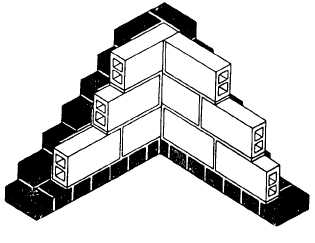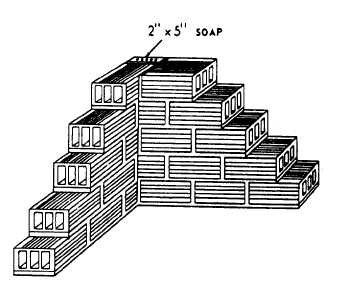will absorb no more than 16 percent of its weight
of water have never given unsatisfactory perform-
ance in resisting the effect of freezing and
thawing action.
Only portland cement-lime
mortar or mortar prepared from masonry cement
should be used if the masonry is exposed to the
weather.
Walls containing structural clay tile have
better heat-insulating qualities than walls com-
posed of solid units because of the dead air space
that exists in tile walls. The resistance to sound
penetration of this type of masonry compares
favorably with the resistance of solid masonry
walls, but it is somewhat less.
The fire resistance of tile walls is considerably
less than the fire resistance of solid masonry walls.
It can be improved by applying a coat of plaster
to the surface of the wall. Partition walls of
structural clay tile 6 in, thick will resist a fire for
1 hr provided the fire produces a temperature of
not more than 1700°F.
The solid material in structural clay tile weighs
about 125 lb per cubic foot. Since the tile
contains hollow cells of various sizes, the weight
of the tile varies, depending upon the manu-
facturer and type. A 6-in. tile wall weighs
approximately 30 lb per square foot, while a 12-in.
tile weighs approximately 45 lb per square foot.
Uses for Structural Clay Tile
Structural clay tile may be used for exterior
walls of either the load-bearing or nonload-
bearing type. It is suitable for both below-grade
and above-grade construction.
Structural load-bearing tile is made from 4-
to 12-in. thicknesses with various face dimensions.
The use of these tiles is restricted by building
codes and specifications, so consult the project
specification.
Nonload-bearing partition walls from the
4- to 12-in. thicknesses are frequently made of
structural clay tile. These walls are easily built,
light in weight, and have good heat- and sound-
insulating properties.
Figure 7-45 shows the use of structural clay
tile as a back unit for a brick wall.
Figure 7-46 shows the use of 8- by 5- by 12-in.
tile in wall construction. Exposure of the open end
of the tile can be avoided by the application of
a thin tile called a SOAP at the corner.
Figure 7-45.-Structural tile used as a backing for bricks.
Figure 7-46.-Eight-inch structural clay tile wall.
STONE MASONRY
Stone masonry is masonry is which the units
consist of natural stone. In RUBBLE stone
masonry, the stones are left in their natural state,
without any kind of shaping. In ASHLAR
masonry, the faces of stones that are to be
placed in surface positions are squared so that the
surfaces of the finished structure will be more or
less continuous plane surfaces. Both rubble and
ashlar work may be either RANDOM or
COURSED.
Random rubble is the crudest of all types of
stonework. Little attention is paid to laying the
7-29



